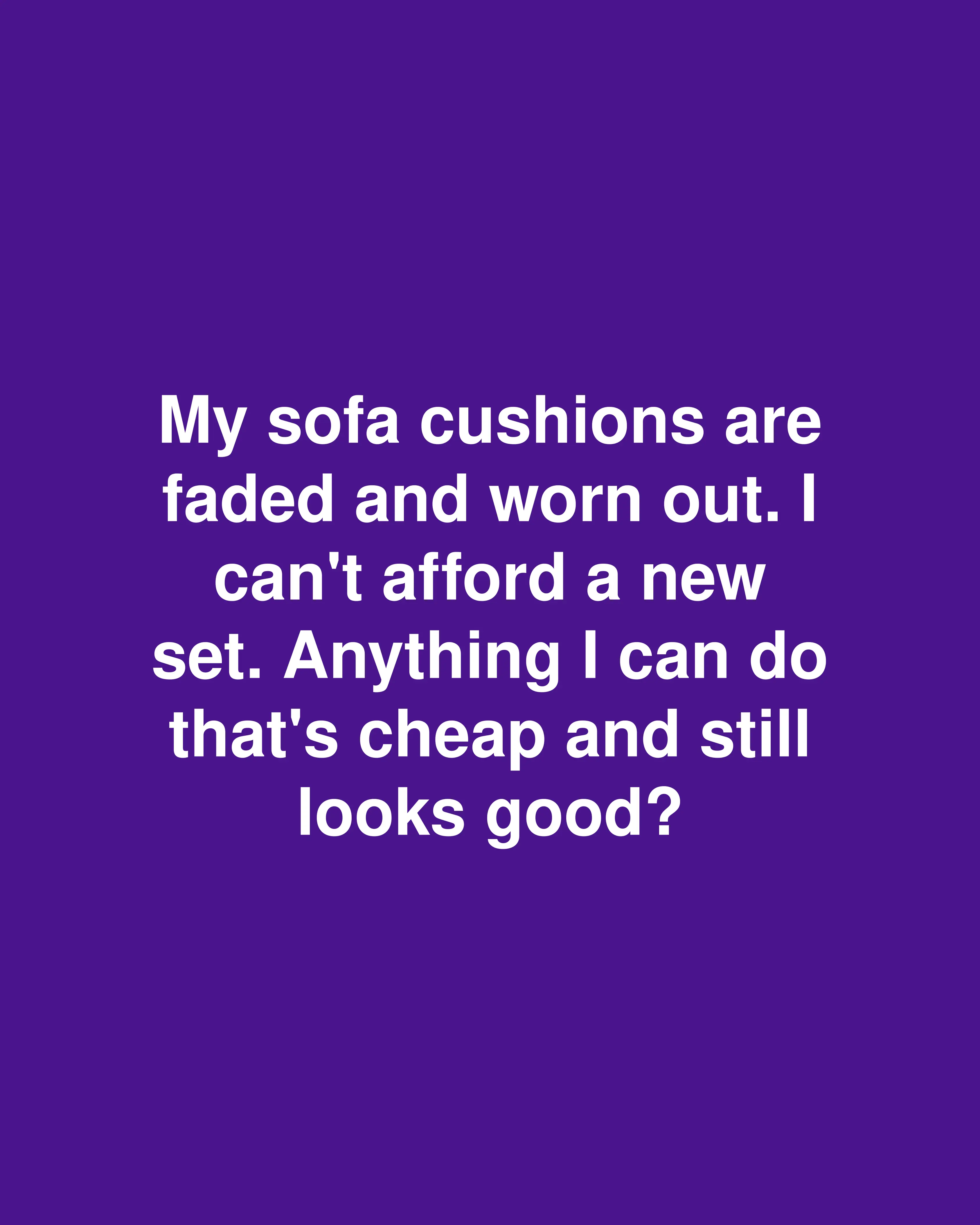Want to save this recipe?
Enter your email below and we’ll send the recipe straight to your inbox!
Breathe New Life Into Your Sofa: Budget-Friendly Ways to Revive Worn Cushions
Ever looked at your once-beautiful sofa and wondered how it went from showroom-fresh to shabby so quickly? You’re not alone. Our sofas endure daily lounging, occasional spills, playful pets, and years of sunlight exposure – all while silently absorbing the wear and tear of everyday life. The good news? You don’t need to splurge on a brand-new couch to refresh your living space. There are creative, affordable ways to transform those tired cushions into something that looks fresh and inviting again.
Why Sofa Cushions Wear Out (And How to Fix Them)
Before diving into solutions, it’s helpful to understand what’s happening to your beloved sofa. Most cushions fade and deteriorate due to three main culprits: sunlight exposure, everyday use, and accidental spills. That sunny spot by the window might be perfect for reading, but those UV rays are slowly draining the color from your cushions. Meanwhile, the constant sitting, lounging, and occasional napping gradually break down cushion filling and stretch out fabric.
Start by assessing your cushions’ condition. Are they simply faded but structurally sound? Do they have stains but still feel comfortable? Or have they lost their shape entirely? Your answers will guide which budget-friendly approach works best for your situation.
DIY Cushion Covers: The Ultimate Makeover Solution
Perhaps the most transformative option is creating your own cushion covers. Don’t worry if you’re not a sewing expert – many designs require just basic straight stitching.
Finding Affordable Fabric Options
Look beyond traditional fabric stores to find budget-friendly materials:
- Clearance sections at fabric stores often have high-quality remnants at fraction of the cost
- Thrift stores frequently have curtains, tablecloths, or bed sheets with plenty of usable fabric
- Online marketplaces sometimes list fabric lots from people downsizing their craft supplies
Simple Sewing Techniques
For the simplest cover:
- Measure your cushion’s width, length, and depth
- Cut two pieces of fabric (top and bottom) adding 1 inch for seam allowance
- Cut one long strip for the sides (measure the perimeter plus 1 inch)
- Sew the side strip to the top piece, then to the bottom, leaving an opening for inserting the cushion
- Install a zipper or velcro closure for easy removal and cleaning
If sewing feels intimidating, try no-sew options using fabric glue, fusible web tape, or even safety pins for temporary solutions.
Transform with Fabric Dyes: Color Revival Magic
If your cushions are faded but still comfortable, fabric dye offers a budget-friendly solution that can completely transform their appearance.
Selecting the Right Dye
Choose a dye formulated for your specific fabric type:
- Natural fibers like cotton and linen accept dye most readily
- Synthetic fabrics require special polyester dyes
- Test a small, hidden section first to ensure good results
The Dyeing Process
For best results:
- Remove cushion covers if possible
- Pre-wash to remove any dirt or finishes that might interfere with dye absorption
- Prepare your dye bath according to package instructions
- Submerge and agitate regularly for even color distribution
- Rinse thoroughly until water runs clear
- Wash with mild detergent to remove excess dye
Creative Embellishments: Add Personality and Style
Sometimes, the simplest additions can make the biggest impact on tired cushions.
Pattern and Texture Ideas
Try these budget-friendly embellishment techniques:
- Use fabric paint with stencils to add geometric patterns or nature-inspired designs
- Apply iron-on patches strategically to cover stains or worn areas
- Add decorative buttons, ribbons, or trim along seams and edges
- Create tufting with buttons to add dimension and disguise sagging areas
Mixing and Matching
Don’t feel limited to a single technique. Consider combining approaches for maximum impact:
- Dye the base fabric a neutral color, then add stenciled patterns
- Cover the main cushions, then create contrasting throw pillows from complementary fabrics
- Use the same color family but mix textures for visual interest
Repurpose What You Already Have
The most budget-friendly approach? Shopping your own home for materials.
Unexpected Fabric Sources
Look around your house for potential cushion cover materials:
- Outgrown jeans can create durable, trendy denim covers
- Vintage scarves can be pieced together for bohemian patchwork designs
- Outdated curtains often contain yards of usable fabric
- Old sweaters can be felted and transformed into cozy winter cushion covers
Creative Combinations
Mix and match unexpected elements:
- Combine several t-shirts into a memory quilt cushion cover
- Pair a sturdy canvas drop cloth with leather belt straps for industrial chic
- Layer lace over solid fabric for instant elegance
Accessorize Strategically: The Power of Throw Pillows
Sometimes the best way to refresh your sofa is to draw attention elsewhere.
Creating Visual Focus Points
Add these affordable accessories to transform your sofa’s appearance:
- Place contrasting throw pillows at each end to frame the space
- Drape a textured throw blanket across worn areas
- Add a runner along the back of the sofa to protect against hair oil and disguise wear
- Position a statement pillow in the center to create a focal point
Seasonal Rotation
Create a seasonal refresh system:
- Swap pillow covers for each season (floral prints for spring, cooler tones for summer, warm textures for fall, festive options for winter)
- This rotation system reduces wear on any single set and keeps your space feeling fresh
Common Mistakes to Avoid
Even with the best intentions, some approaches can make your sofa look worse rather than better.
Fabric Selection Pitfalls
Avoid these common errors:
- Choosing lightweight fabrics that won’t stand up to daily use
- Selecting white or very light colors for high-traffic homes
- Using non-washable fabrics when you have children or pets
- Picking trendy patterns that you’ll quickly tire of
DIY Disasters
Prevent these common DIY mishaps:
- Skipping pre-washing (which leads to shrinkage after the first cleaning)
- Rushing measurements (resulting in too-tight or baggy covers)
- Using the wrong type of thread or needle for your fabric
- Choosing incompatible dyes for your fabric type
Extending the Life of Your Refreshed Cushions
Once you’ve given your cushions a new lease on life, protect your investment with these simple habits:
- Rotate cushions weekly to distribute wear evenly
- Vacuum regularly to prevent dirt from embedding in fibers
- Address spills immediately before they set as stains
- Use fabric protector spray on new covers
- Keep pets off furniture or use designated washable pet throws
- Consider slip-covering during parties or when children have friends over
Quick Recap: From Drab to Fab on a Budget
Refreshing your sofa cushions doesn’t require a design degree or deep pockets – just a little creativity and effort. Whether you choose to sew new covers, experiment with dyes, add decorative elements, or strategically accessorize, you can transform your living space for a fraction of replacement costs.
The best approach often combines several techniques: perhaps dyeing the base cushions a fresh color, adding a few new throw pillows, and incorporating a cozy blanket. This layered strategy creates depth and interest while maximizing your budget.
Remember, imperfection can be charming – those slightly visible stitches or the subtle variations in your dye job often add character and a personal touch that store-bought items simply can’t match.
Frequently Asked Questions
How much fabric do I need to cover standard sofa cushions?
For a typical three-seat sofa with removable back cushions, plan for 5-7 yards of 54-inch wide fabric. Always measure your specific cushions and add 15% extra for pattern matching and mistakes.
Can I dye polyester cushion covers?
Yes, but you’ll need special disperse dyes designed for synthetic fabrics. Regular fabric dyes won’t adhere properly to polyester. Follow the manufacturer’s instructions carefully, as these typically require higher temperatures than natural fiber dyes.
What’s the easiest way to refresh cushions if I don’t sew?
Try envelope-style pillow covers that require minimal sewing, or explore no-sew options like fabric wrap techniques secured with safety pins hidden underneath. Alternatively, strategic placement of throw blankets and pillows can disguise worn areas without any sewing.
How often should I wash cushion covers?
For average households, washing every 3-6 months is sufficient. Homes with pets, small children, or allergy sufferers might need monthly washing. Always follow the fabric care instructions to prevent shrinkage or damage.


